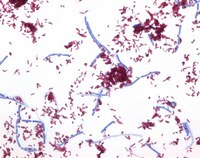108512 Sigma-AldrichAFB-Color solution de carbolfuchsine
for the microscopic investigation of acid-fast bacteria (AFB) (cold staining)
More>> for the microscopic investigation of acid-fast bacteria (AFB) (cold staining) Less<<Produits recommandés
Aperçu
| Replacement Information |
|---|
Prix & Disponibilité
| Référence | Disponibilité | Conditionnement | Qté | Prix | Quantité | |
|---|---|---|---|---|---|---|
| 1085120500 |
|
Flacon plastique | 500 ml |
|
— | |
| 1085122500 |
|
Flacon plastique | 2.5 l |
|
— |
| Références bibliographiques |
|---|
| Informations produit | |
|---|---|
| Code SH | 3212 90 00 |
| Quality Level | MQ400 |
| Applications | |
|---|---|
| Application | for the microscopic investigation of acid-fast bacteria (AFB) (cold staining) |
| Informations biologiques |
|---|
| Informations physico-chimiques | |
|---|---|
| Densité | 0.99 g/cm3 (20 °C) |
| Point d'éclair | 48 °C |
| Valeur de pH | 3.6 (H₂O, 20 °C) |
| Dimensions |
|---|
| Informations sur les matériaux |
|---|
| Informations toxicologiques |
|---|
| Informations sur la sécurité | |
|---|---|
| Catégories de danger | inflammable, nocif, corrosif, mutagène |
| Notifications sur l'utilisation du produit |
|---|
| Informations relatives au stockage et à l'expédition | |
|---|---|
| Stockage | Conserver de +15°C à +25°C. |
| Informations sur l'emballage |
|---|
| Information complémentaire |
|---|
| Caractéristiques |
|---|
| Global Trade Item Number | |
|---|---|
| Référence | GTIN |
| 1085120500 | 04022536105888 |
| 1085122500 | 04022536557175 |
Documentation
AFB-Color solution de carbolfuchsine FDS
| Titre |
|---|
AFB-Color solution de carbolfuchsine Certificats d'analyse
| Référence | Conditionnement | Spécification | Numéro de lot |
|---|---|---|---|
| 1085120500 | Flacon plastique | Document de spécification PDF | |
| 1085122500 | Flacon plastique | Document de spécification PDF |
Manuels d'utilisation
| Titre |
|---|
| User Guide 108512 |











